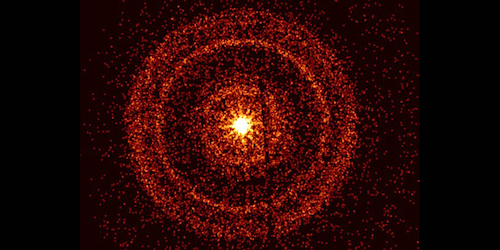Gamma-Ray Burst Tightens Constraints on Quantum Gravity
Send a pulse of white light into an optical fiber, and the red components of its spectrum will reach the far end before the blue components do. Send the same pulse through a vacuum, and the result will be a dead heat between all frequencies. The absence of frequency dispersion is a consequence of a fundamental relativity symmetry known as Lorentz invariance. Some theories of quantum gravity, however, predict that, for very high photon energies, a vacuum behaves like a medium. Researchers at the Large High Altitude Air Shower Observatory (LHAASO) in China have now tested Lorentz invariance by analyzing measurements of a gamma-ray burst (GRB) [1]. The lack of an observable Lorentz-invariance violation allowed the team to raise the energy threshold at which quantum gravity effects might become evident.
GRBs—cosmic explosions emitting high-energy radiation—make excellent subjects for testing Lorentz invariance, as their great distance means that a small dispersion translates into a detectable spread of arrival times. The LHAASO team studied GRB 221009A, the brightest such event ever observed and, at a distance of about 2.4 billion light years, a relatively close one. Although this proximity would narrow any arrival-time spread compared to more distant events, the high photon flux offered a unique opportunity for statistically significant measurements.
Analyzing how the GRB’s energy spectrum changed over time, the researchers constrained the two main terms describing light’s potential frequency dispersion (those varying linearly or quadratically with photon energy). For the linear term, they obtained a similar constraint to that previously derived from GRB observations. For the quadratic one, they established a five- to sevenfold greater energy threshold at which quantum gravity could emerge. Future observations of the initial stages of a GRB could offer even more sensitive Lorentz-violation tests, the researchers say.
–Marric Stephens
Marric Stephens is a Corresponding Editor for Physics Magazine based in Bristol, UK.
References
- Z. Cao et al. (LHAASO Collaboration), “Stringent tests of Lorentz invariance violation from LHAASO observations of GRB 221009A,” Phys. Rev. Lett. 133, 071501 (2024).




